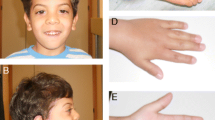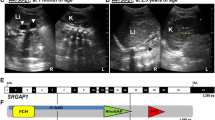Abstract
By exome sequencing, we found de novo SMARCB1 mutations in two of five individuals with typical Coffin-Siris syndrome (CSS), a rare autosomal dominant anomaly syndrome. As SMARCB1 encodes a subunit of the SWItch/Sucrose NonFermenting (SWI/SNF) complex, we screened 15 other genes encoding subunits of this complex in 23 individuals with CSS. Twenty affected individuals (87%) each had a germline mutation in one of six SWI/SNF subunit genes, including SMARCB1, SMARCA4, SMARCA2, SMARCE1, ARID1A and ARID1B.

Similar content being viewed by others
References
Reisman, D., Glaros, S. & Thompson, E.A. Oncogene 28, 1653–1668 (2009).
Wilson, B.G. & Roberts, C.W. Nat. Rev. Cancer 11, 481–492 (2011).
Clapier, C.R. & Cairns, B.R. Annu. Rev. Biochem. 78, 273–304 (2009).
Bultman, S. et al. Mol. Cell 6, 1287–1295 (2000).
Hargreaves, D.C. & Crabtree, G.R. Cell Res. 21, 396–420 (2011).
Xue, Y. et al. Proc. Natl. Acad. Sci. USA 97, 13015–13020 (2000).
Coffin, G.S. & Siris, E. Am. J. Dis. Child. 119, 433–439 (1970).
Bamshad, M.J. et al. Nat. Rev. Genet. 12, 745–755 (2011).
Wittwer, C.T., Reed, G.H., Gundry, C.N., Vandersteen, J.G. & Pryor, R.J. Clin. Chem. 49, 853–860 (2003).
Reyes, J.C. et al. EMBO J. 17, 6979–6991 (1998).
Schneppenheim, R. et al. Am. J. Hum. Genet. 86, 279–284 (2010).
Taylor, M.D. et al. Am. J. Hum. Genet. 66, 1403–1406 (2000).
Boyd, C. et al. Clin. Genet. 74, 358–366 (2008).
Hadfield, K.D. et al. J. Med. Genet. 45, 332–339 (2008).
Acknowledgements
We thank all the family members for participating in this study. This work was supported by research grants from the Ministry of Health, Labour and Welfare (to N. Miyake, H.S. and N. Matsumoto), the Japan Science and Technology Agency (to N. Matsumoto), the Strategic Research Program for Brain Sciences (to N. Matsumoto), the Japan Epilepsy Research Foundation (to H.S.) and the Takeda Science Foundation (to N. Matsumoto and N. Miyake). This study was also funded by a Grant-in-Aid for Scientific Research on Innovative Areas (Foundation of Synapse and Neurocircuit Pathology) from the Ministry of Education, Culture, Sports, Science and Technology of Japan (to N. Matsumoto), a Grant-in-Aid for Scientific Research from the Japan Society for the Promotion of Science (to N. Matsumoto), a Grant-in-Aid for Young Scientists from the Japan Society for the Promotion of Science (to N. Miyake and H.S.) and a Grant for 2011 Strategic Research Promotion of Yokohama City University (to N. Matsumoto). This study was performed at the Advanced Medical Research Center at Yokohama City University. Informed consent was obtained from all the families of affected individuals. The Institutional Review Board of Yokohama City University approved this study.
Author information
Authors and Affiliations
Contributions
Y.T., S. Miyatake, I.O., H.D., H.S. and N. Miyake performed exome sequencing and Sanger sequencing. Y.T., M.S., K.O., I.O., T.M., H.D., H.S. and N. Miyake performed data management and analysis. N.O., H.O., T. Kosho, Y.I., Y.H.-K., T. Kaname, K.N., H.K., K.W., Y.F., T.H., M.K., Y.H., T.Y., S.Y., S. Mizuno, S.S., T.I., T.N., T.O. and N.N. provided clinical materials after careful evaluation. Y.T., N. Miyake and N. Matsumoto wrote the manuscript. N. Matsumoto designed and oversaw all aspects of the study.
Corresponding authors
Ethics declarations
Competing interests
The authors declare no competing financial interests.
Supplementary information
Supplementary Text and Figures
Supplementary Methods, Supplementary Figures 1–8 and Supplementary Tables 1–3 (PDF 6781 kb)
Rights and permissions
About this article
Cite this article
Tsurusaki, Y., Okamoto, N., Ohashi, H. et al. Mutations affecting components of the SWI/SNF complex cause Coffin-Siris syndrome. Nat Genet 44, 376–378 (2012). https://doi.org/10.1038/ng.2219
Received:
Accepted:
Published:
Issue Date:
DOI: https://doi.org/10.1038/ng.2219
- Springer Nature America, Inc.
This article is cited by
-
Genome-wide association studies for economically important traits in mink using copy number variation
Scientific Reports (2024)
-
Protein destabilization underlies pathogenic missense mutations in ARID1B
Nature Structural & Molecular Biology (2024)
-
ARID3a from the ARID family: structure, role in autoimmune diseases and drug discovery
Acta Pharmacologica Sinica (2023)
-
Abnormal chromatin remodeling caused by ARID1A deletion leads to malformation of the dentate gyrus
Cell Death & Differentiation (2023)
-
SWI/SNF chromatin remodeler complex within the reward pathway is required for behavioral adaptations to stress
Nature Communications (2022)





